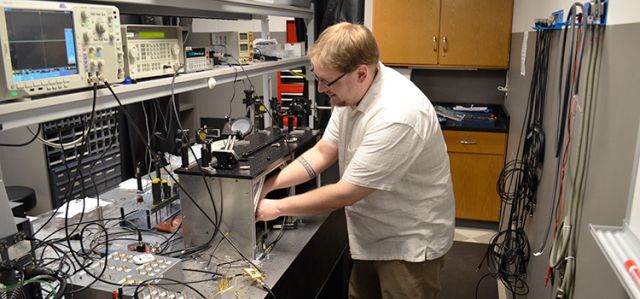Speckle-field Propagation in “Frozen” Turbulence: Brightness Function Approach
Document Type
Article
Publication Date
8-1-2006
Publication Source
Journal of the Optical Society of America A
Abstract
Speckle-field long- and short-exposure spatial correlation characteristics for target-in-the-loop (TIL) laser beam propagation and scattering in atmospheric turbulence are analyzed through the use of two different approaches: the conventional Monte Carlo (MC) technique and the recently developed brightness function (BF) method. Both the MC and the BF methods are applied to analysis of speckle-field characteristics averaged over target surface roughness realizations under conditions of “frozen” turbulence. This corresponds to TIL applications where speckle-field fluctuations associated with target surface roughness realization updates occur within a time scale that can be significantly shorter than the characteristic atmospheric turbulence time. Computational efficiency and accuracy of both methods are compared on the basis of a known analytical solution for the long-exposure mutual correlation function. It is shown that in the TIL propagation scenarios considered the BF method provides improved accuracy and requires significantly less computational time than the conventional MC technique. For TIL geometry with a Gaussian outgoing beam and Lambertian target surface, both analytical and numerical estimations for the speckle-field long-exposure correlation length are obtained. Short-exposure speckle-field correlation characteristics corresponding to propagation in “frozen” turbulence are estimated using the BF method. It is shown that atmospheric turbulence–induced static refractive index inhomogeneities do not significantly affect the characteristic correlation length of the speckle field, whereas long-exposure spatial correlation characteristics are strongly dependent on turbulence strength.
Inclusive pages
1924-1936
ISBN/ISSN
1084-7529
Copyright
Copyright © 2006, Optical Society of America
Publisher
Optical Society of America
Volume
23
Issue
8
Place of Publication
Washington, DC
Peer Reviewed
yes
eCommons Citation
Dudorov, V. V.; Vorontsov, Mikhail; and Kolosov, V. V., "Speckle-field Propagation in “Frozen” Turbulence: Brightness Function Approach" (2006). Electro-Optics and Photonics Faculty Publications. 103.
https://ecommons.udayton.edu/eop_fac_pub/103
COinS




Comments
© 2006 Optical Society of America. One print or electronic copy may be made for personal use only. Systematic reproduction and distribution, duplication of any material in this paper for a fee or for commercial purposes, or modifications of the content of this paper are prohibited.
Permission documentation on file.